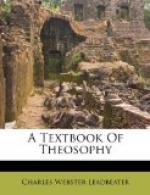This atom of the seventh world is the ultimate atom of the physical world—not any of the atoms of which chemists speak, but that ultimate out of which all their atoms are made. We have at this stage arrived at that condition of affairs in which the vast whirling sphere contains within itself seven types of matter, all one in essence, because all built of the same kind of bubbles, but differing in their degree of density. All these types are freely intermingled, so that specimens of each type would be found in a small portion of the sphere taken at random in any part of it, with, however, a general tendency of the heavier atoms to gravitate more and more towards the centre.
The seventh impulse sent out from the Third Aspect of the Deity does not, as before, draw back the physical atoms which were last made into the original dissociated bubbles, but draws them together into certain aggregations, thus making a number of different kinds of what may be called proto-elements, and these again are joined together into the various forms which are known to science as chemical elements. The making of these extends over a long period of ages, and they are made in a certain definite order by the interaction of several forces, as is correctly indicated in Sir William Crookes’s paper, The Genesis of the Elements. Indeed the process of their making is not even now concluded; uranium is the latest and heaviest element so far as we know, but others still more complicated may perhaps be produced in the future.
As ages rolled on the condensation increased, and presently the stage of a vast glowing nebula was reached. As it cooled, still rapidly rotating, it flattened into a huge disc and gradually broke up into rings surrounding a central body—an arrangement not unlike that which Saturn exhibits at the present day, though on a far larger scale. As the time drew near when the planets would be required for the purposes of evolution, the Deity sets up somewhere in the thickness of each ring a subsidiary vortex into which a great deal of the matter of the ring was by degrees collected. The collisions of the gathered fragments caused a revival of the heat, and the resulting planet was for a long time a mass of glowing gas. Little by little it cooled once more, until it became fit to be the theatre of life such as ours. Thus were all the planets formed.
Almost all the matter of those interpenetrating worlds was by this time concentrated into the newly formed planets. Each of them was and is composed of all those different kinds of matter. The earth upon which we are now living is not merely a great ball of physical matter, built of the atoms of that lowest world, but has also attached to it an abundant supply of matter of the sixth, the fifth, the fourth and other worlds. It is well known to all students of science that particles of matter never actually touch one another, even in the hardest of substances. The spaces between them are always far greater in




